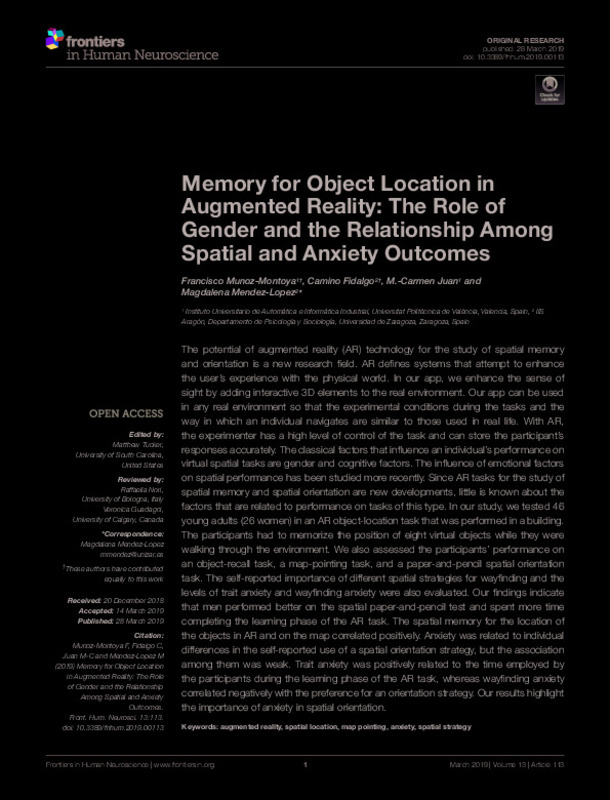JavaScript is disabled for your browser. Some features of this site may not work without it.
Buscar en RiuNet
Listar
Mi cuenta
Estadísticas
Ayuda RiuNet
Admin. UPV
Memory for Object Location in Augmented Reality: The Role of Gender and the Relationship Among Spatial and Anxiety Outcomes
Mostrar el registro sencillo del ítem
Ficheros en el ítem
| dc.contributor.author | Muñoz-Montoya, Francisco Miguel
|
es_ES |
| dc.contributor.author | Fidalgo, Camino
|
es_ES |
| dc.contributor.author | Juan, M.-Carmen
|
es_ES |
| dc.contributor.author | Mendez-Lopez, Magdalena
|
es_ES |
| dc.date.accessioned | 2023-05-04T18:01:54Z | |
| dc.date.available | 2023-05-04T18:01:54Z | |
| dc.date.issued | 2019-03-28 | es_ES |
| dc.identifier.issn | 1662-5161 | es_ES |
| dc.identifier.uri | http://hdl.handle.net/10251/193131 | |
| dc.description.abstract | [EN] The potential of augmented reality (AR) technology for the study of spatial memory and orientation is a new research field. AR defines systems that attempt to enhance the user's experience with the physical world. In our app, we enhance the sense of sight by adding interactive 3D elements to the real environment. Our app can be used in any real environment so that the experimental conditions during the tasks and the way in which an individual navigates are similar to those used in real life. With AR, the experimenter has a high level of control of the task and can store the participant¿s responses accurately. The classical factors that influence an individual¿s performance on virtual spatial tasks are gender and cognitive factors. The influence of emotional factors on spatial performance has been studied more recently. Since AR tasks for the study of spatial memory and spatial orientation are new developments, little is known about the factors that are related to performance on tasks of this type. In our study, we tested 46 young adults (26 women) in an AR object-location task that was performed in a building. The participants had to memorize the position of eight virtual objects while they were walking through the environment. We also assessed the participants' performance on an object-recall task, a map-pointing task, and a paper-and-pencil spatial orientation task. The self-reported importance of different spatial strategies for wayfinding and the levels of trait anxiety and wayfinding anxiety were also evaluated. Our findings indicate that men performed better on the spatial paper-and-pencil test and spent more time completing the learning phase of the AR task. The spatial memory for the location of the objects in AR and on the map correlated positively. Anxiety was related to individual differences in the self-reported use of a spatial orientation strategy, but the association among them was weak. Trait anxiety was positively related to the time employed by the participants during the learning phase of the AR task, whereas wayfinding anxiety correlated negatively with the preference for an orientation strategy. Our results highlight the importance of anxiety in spatial orientation. | es_ES |
| dc.description.sponsorship | This work was funded by: the Spanish Ministry of Economy, Industry and Competitiveness through the AR3Senses project (TIN2017-87044-R) and cofinanced by the ERDF (European Regional Development Fund); the Gobierno de Aragon (Departamento de Innovacion, Investigacion y Universidad) and FEDER "Construyendo Europa desde Aragon" for the research group S31_ 17D; the Fundacion Bancaria Ibercaja and Universidad de Zaragoza (JIUZ-2018-SOC-12). | es_ES |
| dc.language | Inglés | es_ES |
| dc.publisher | Frontiers Media SA | es_ES |
| dc.relation.ispartof | Frontiers in Human Neuroscience | es_ES |
| dc.rights | Reconocimiento (by) | es_ES |
| dc.subject | Augmented reality | es_ES |
| dc.subject | Spatial location | es_ES |
| dc.subject | Map pointing | es_ES |
| dc.subject | Anxiety | es_ES |
| dc.subject | Spatial strategy | es_ES |
| dc.subject.classification | LENGUAJES Y SISTEMAS INFORMATICOS | es_ES |
| dc.title | Memory for Object Location in Augmented Reality: The Role of Gender and the Relationship Among Spatial and Anxiety Outcomes | es_ES |
| dc.type | Artículo | es_ES |
| dc.identifier.doi | 10.3389/fnhum.2019.00113 | es_ES |
| dc.relation.projectID | info:eu-repo/grantAgreement/AEI/Plan Estatal de Investigación Científica y Técnica y de Innovación 2013-2016/TIN2017-87044-R/ES/REALIDAD AUMENTADA A TRAVES DE VARIOS CANALES SENSORIALES. APLICACION A PROCESOS DE ORIENTACION Y LOCALIZACION ESPACIAL/ | es_ES |
| dc.relation.projectID | info:eu-repo/grantAgreement/UNIZAR//JIUZ-2018-SOC-12/ | es_ES |
| dc.rights.accessRights | Abierto | es_ES |
| dc.contributor.affiliation | Universitat Politècnica de València. Escuela Técnica Superior de Ingenieros Industriales - Escola Tècnica Superior d'Enginyers Industrials | es_ES |
| dc.description.bibliographicCitation | Muñoz-Montoya, FM.; Fidalgo, C.; Juan, M.; Mendez-Lopez, M. (2019). Memory for Object Location in Augmented Reality: The Role of Gender and the Relationship Among Spatial and Anxiety Outcomes. Frontiers in Human Neuroscience. 13(113):1-15. https://doi.org/10.3389/fnhum.2019.00113 | es_ES |
| dc.description.accrualMethod | S | es_ES |
| dc.relation.publisherversion | https://doi.org/10.3389/fnhum.2019.00113 | es_ES |
| dc.description.upvformatpinicio | 1 | es_ES |
| dc.description.upvformatpfin | 15 | es_ES |
| dc.type.version | info:eu-repo/semantics/publishedVersion | es_ES |
| dc.description.volume | 13 | es_ES |
| dc.description.issue | 113 | es_ES |
| dc.identifier.pmid | 31001098 | es_ES |
| dc.identifier.pmcid | PMC6455057 | es_ES |
| dc.relation.pasarela | S\381554 | es_ES |
| dc.contributor.funder | Fundación Bancaja | es_ES |
| dc.contributor.funder | Gobierno de Aragón | es_ES |
| dc.contributor.funder | Universidad de Zaragoza | es_ES |
| dc.contributor.funder | AGENCIA ESTATAL DE INVESTIGACION | es_ES |
| dc.contributor.funder | European Regional Development Fund | es_ES |








